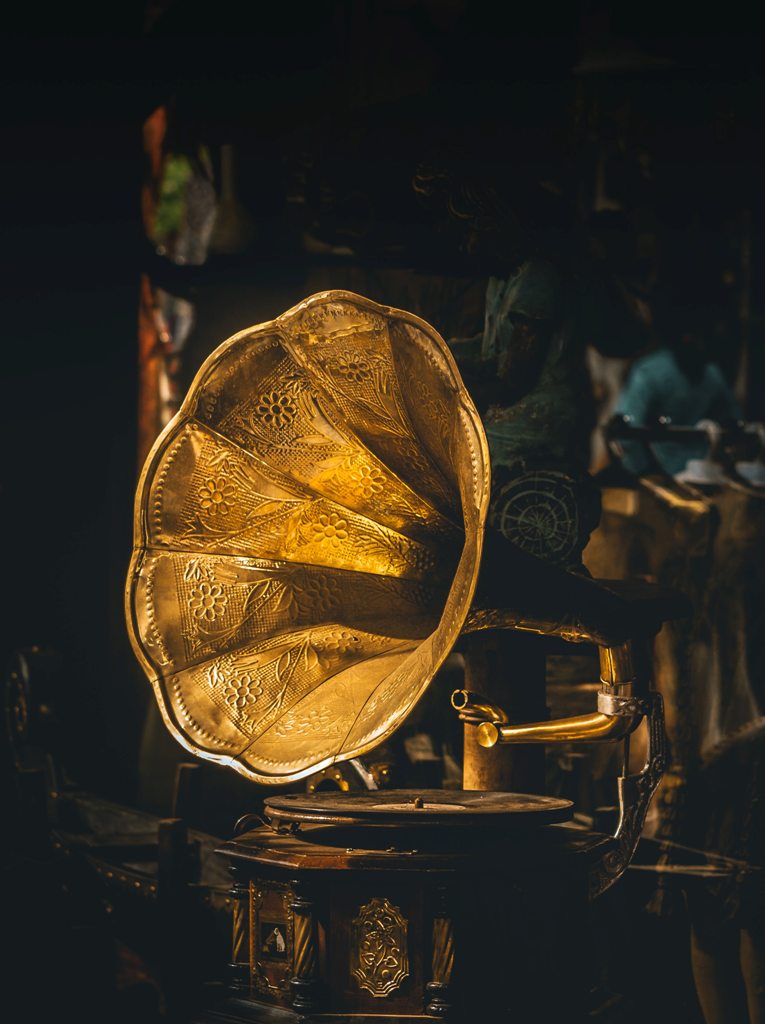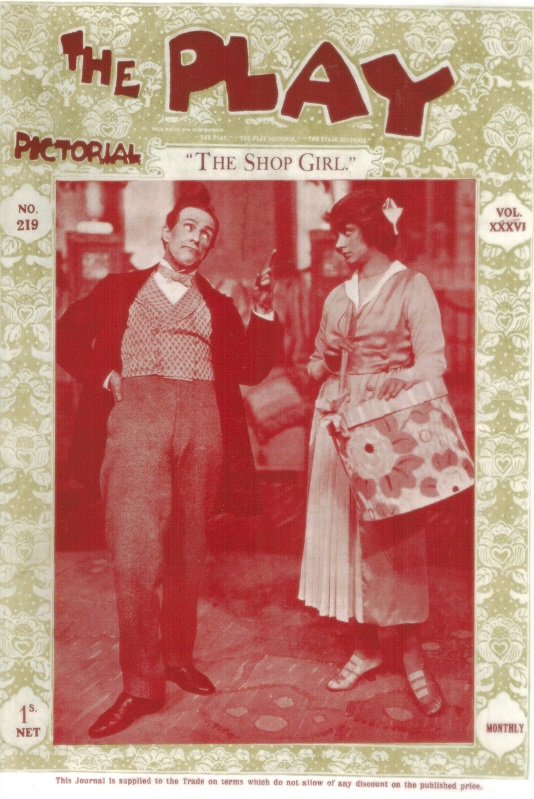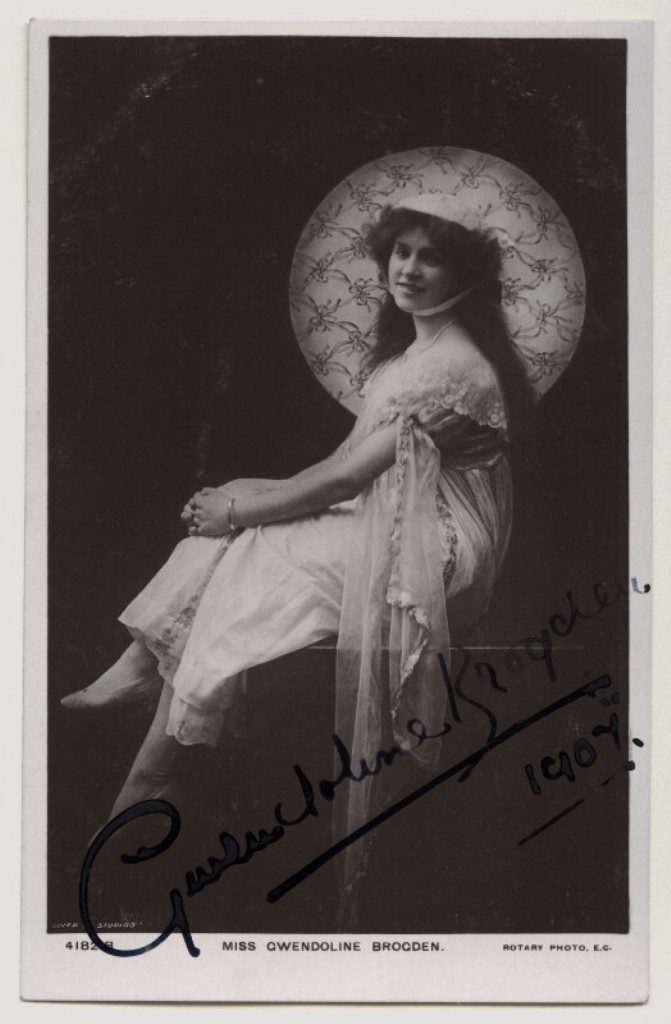Thomas Krebs
Operetta Research Center
1 July, 2020
If you are interested in what original audiences of early 20th century English operetta and musical comedy heard, there is a great source for such recordings – the record label Paleophonics. Dominic Combe prepares CDs for them from his huge collection of shellacs and a few cylinders.

An old grammophone record player in a second-hand shop. (Photo: Sudhith Xavier / Unsplash)
I came across these somewhat hard-to-find CDs on the website of the mail-order company “Norbeck, Peters and Ford,” which is specialized in historical performances from the beginning of recorded sound all the way through to the 1960s.
There are now over fifty Paleophonics CDs, and more are being prepared or scheduled for future release. Each CD comes with a lavishly illustrated A5 program booklet: with reviews, information about the shows and fantastic publicity photographs, and artwork from the original London productions, in the form of reproductions of the magazine Play Pictorial.

The cover of the Palaeophonics release of “The Shop Girl.” (Photo: Palaeophonics)
British and European as well as American composers and works are represented, such as Charles Cuvillier’s The Lilac Domino, which ran for 747 performances in 1918/19; the 1924 Daly’s Theatre production of Madame Pompadour by Leo Fall with Evelyn Laye and Derek Oldham; Rudolf Friml’s The Blue Kitten and Rosemary; Jean Gilbert’s A Lady of the Rose (Die Frau im Hermelin) and Katja the Dancer; or Louis A. Hirsch’s Hullo Ragtime, which opened at the London Hippodrome on 23 December 1912, and Going Up from the 1918 Gaiety Theatre production featuring Marjorie Gordon, Evelyn Laye and Joseph Coyne. (For an article on Paleophonics’ The Shop Girl, click here.)
The CD of Oscar Straus’ The Chocolate Soldier contains the super rare Odeon recordings of the 1910 London Lyric Theatre production.

The Paleophonics cast album of Oscar Straus’ “The Chocolate Soldier.”
Follow the Crowd (the London version of Stop! Look! Listen!) by Irving Berlin from 1916 includes all thirteen original cast recordings with the American stars Evelyn Laye and Joseph Coyne, and the London stars Blanche Tomlin, Fay Compton, Robert Hale, and Tom Walls.
One album is devoted to recordings by Lily Elsie: with Pamela (1917/8) and music by Arthur Wimperis and Frederic Norton), plus The Blue Train with music by Robert Stolz (the English version of Mädi), additional numbers by Ivy St. Helier, recorded in 1927.

Long before vintage recordss and tapes came back into fashion there were shellac and cylinder frecordings. (Photo: Mick Haupt)
Mr. Combe was kind enough to answer some questions about his CDs for the Operetta Research Center.
How did you get started?
My paternal grandmother (1896-1979) was musical, went to finishing school in Dresden in 1913, and she played the violin. She had fine album sets of Mozart’s operas recorded in the 1930s at Glyndebourne and song cycles of Hugo Wolf among other treasures. My other grandmother liked musical comedy and went with her fiancé and two of her sisters to see the Daly’s production of the Merry Widow in 1907. When I was a child in the 1960s, she still had a well worn set of the Merry Widow Lancers of the period.
My mother had a great many shellac and LP records, most of it of Viennese operetta and café music, as well as Mozart, Haydn and French songs. You can see the influences!

Lily Elsie and Joseph Coyne in ‘The Merry Widow’, 1907. Elsie and Coyne are playing the parts of ‘Sonia’ and ‘Prince Danilo’ respectively.
Do the recordings find you – or do you find them?
I have acquired a huge collection of musical comedy records, almost all of it on shellac discs, but occasionally on cylinders. I do start with a specific show in mind, but getting everything together is a long business, and so I have several projects on the go and gradually amass the necessary material over months and even years. Serendipity frequently initiates a project. I can have, for example, an operetta such as Emile Lassailly’s 1917 Carminetta. It has taken years to find all the vocal records, even though it was popular and certain rather battered copies always of the same title turned up. The final records I have tracked down at the British Library: the orchestral selections which serve as an overture, supplying parts of the musical score not otherwise provided. The most difficult records to find are usually acoustically recorded parts such as overtures and ballet sequences, and also male vocal solos, unless very famous or popular.
Do you have any particular favorites?
I have plenty of favorites, all based on the quality of the music and the show, rather than rarity or difficulty in the finding.
What is it that you find attractive about these vintage recordings as compared to modern productions?
I like just about everything, but above all, it’s the singing style: smooth, pure delivery, pleasing, clear pronunciation, no unnecessary vibrato/tremolo, no brassy delivery. Original cast members and conductors are a plus. My ears are totally accustomed to acoustic and early electric recordings, as you might imagine.
Are you ever in touch with descendants of composers or singers of these vintage shows?
Yes, I have been in touch with descendants. Not many, though. The only two were Gwendoline Brogden and her family. She’s of Bric a Brac (1915) and A Southern Maid (1920) fame. Then there’s Amy Evans, who was one of the last Savoy Opera Company singers, having recorded Yeomen of the Guard 1907 for Pathé and Welsh ballads for Edison. I was able to supply, with the help of friends, almost all her recordings for her family. It brings things back to life.

Gwendoline Brogden, photographed by The Dover Street Studios Ltd, published by Rotary Photographic Co Ltd postcard print, circa 1907. (Photo: National Portrait Gallery, London)
What future albums are you planning?
Carminetta 1917; Afgar or Les Plaisirs Andalous 1919; Razzle Dazzle 1916; My Lady Frayle 1916; de Courville’s 1918 revue Box o’ Tricks; the English version of Abraham’s Victoria and Her Hussar 1931. There’s a few …
For more information on the company’s cast albums, click here. For the restored original 1907 Berlin cast of Die lustige Witwe, click here.

I am so glad that you have drawn attention to Dominic Coombe and his Paleophonics label. There is much joy fun in store for purchasers.
H! ,I’ve treid to enter my adress in order to receive your newsletter.It failed.That’s why I try it this way !Will you please put me on your adress list for the newsletter ? Thanks ,Best ,Walther ,Netherlands
Can you put me in touch with Dominic. I have had to change my computer and have lost many email addresses
My above add
Does this site still exist?